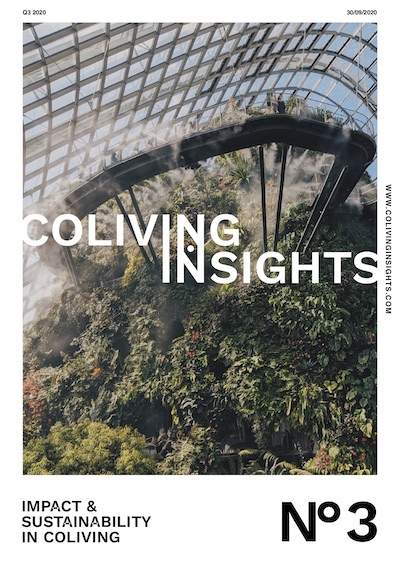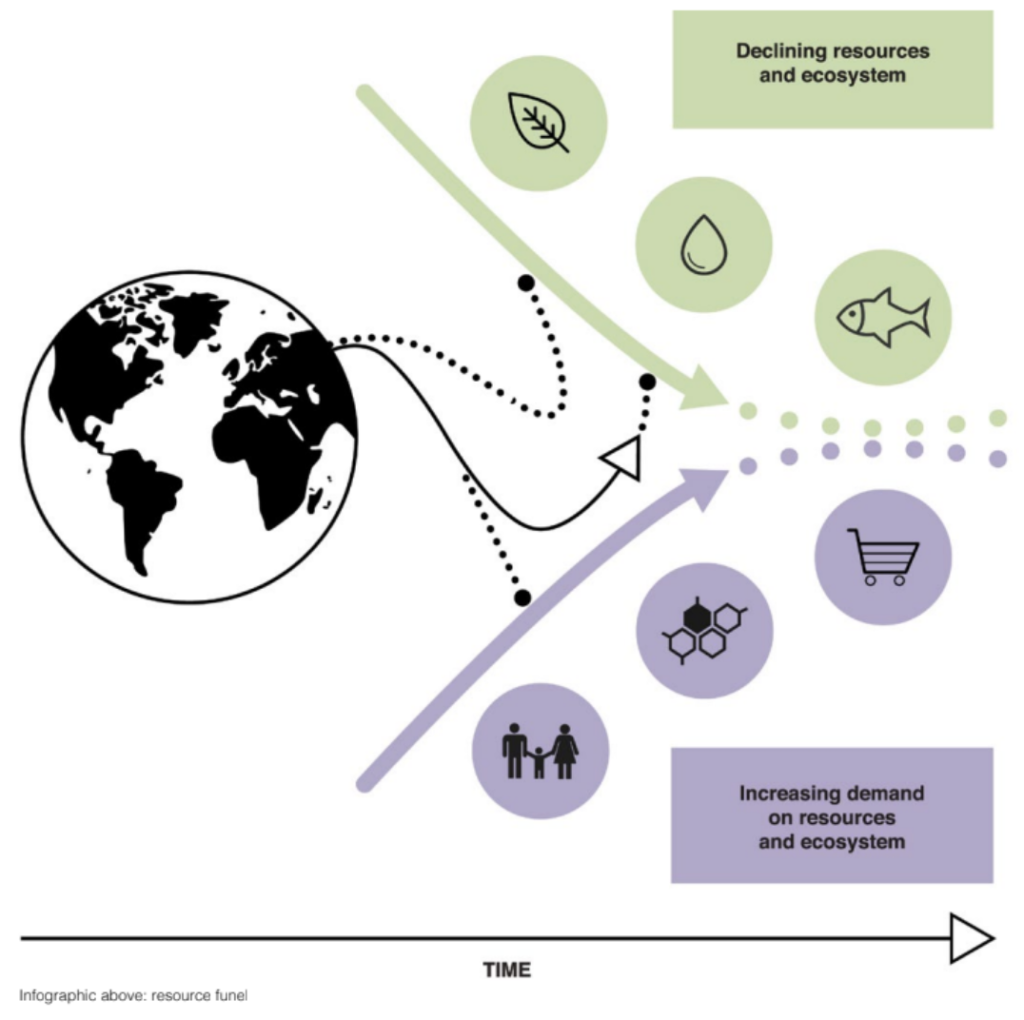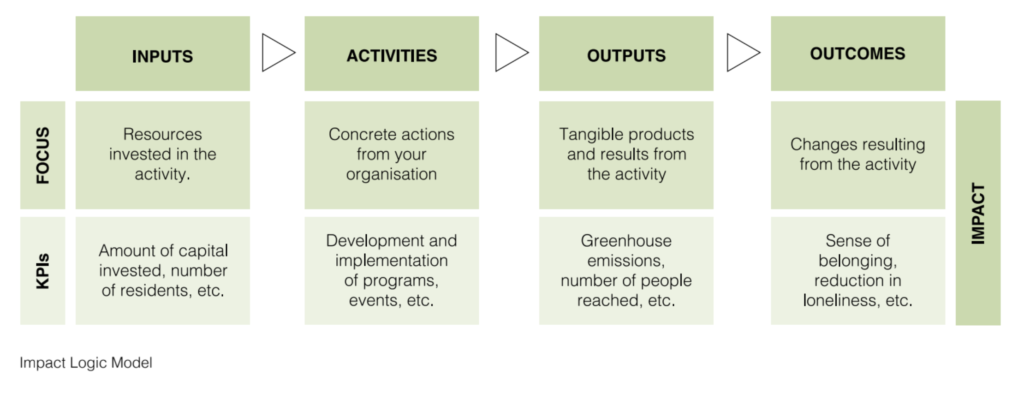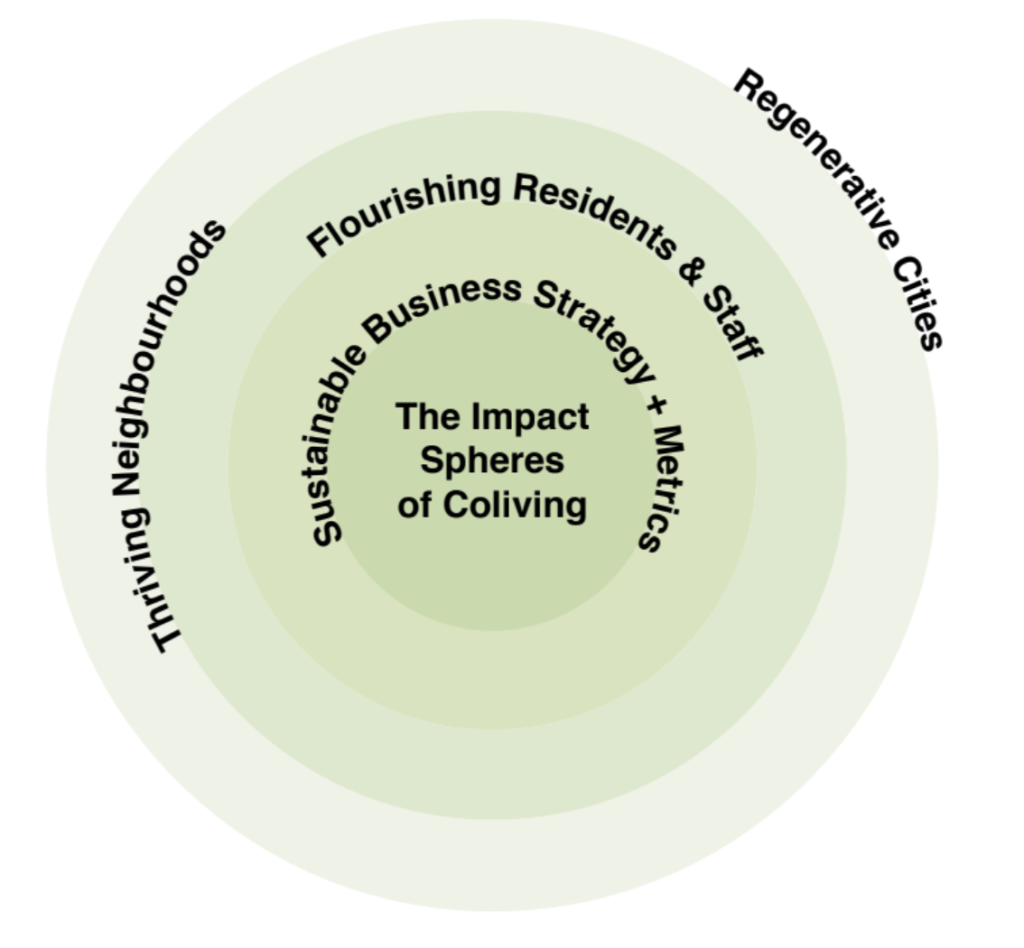As an impact-driven consultancy for coliving investors, developers and operators, our aim is to help embed social value – social, environmental and economic impact – into the core of coliving businesses, designs, operations and communities.
This article was originally featured in Coliving Insights No.3 : Impact & Sustainability in Coliving and explores just how to do so, by analysing industry best practices and case studies. Coliving Insights No.3 explores the notion of impact and sustainability in coliving, with contributions from 30+ thought leaders and innovators around the topics of social value, public policies, social impact and technological innovation.

You can read this article below – and the third of edition of Coliving Insights – to discover how coliving professionals can do their part in providing products and experiences that are inclusive, regenerative and inspiring.
Why impact and sustainability?
Our vision at Coliving Insights is to provide the coliving sector with resources and insights that help push the industry to create innovative and impactful products. But what does an impactful coliving product really look and feel like? This is what we’re exploring in this edition with the contributions of over 20 industry experts and researchers who have written about what impact and sustainability mean to them, and how we as coliving professionals can do our part in providing products and experiences that are inclusive, regenerative and inspiring.
Before diving into some of the projects we gathered for this edition, we wanted to give our own definition of impact and sustainability and share our vision of how the coliving sector can really fulfil its potential. In this edition’s cover story, we will explore the impact, sustainability and social value sectors from a bird’s eye perspective, and reflect on how real estate and coliving professionals can ensure they are going above and beyond when it comes to these elements of their brands. We will also give examples of how best to embed these elements into the core of your business strategy and culture, based on existing frameworks and best practice case studies.
So why did we choose to focus this edition of Coliving Insights on impact and sustainability? It goes without saying that our planet and all of its species are at a crossroads between a neo-liberal economic market and a finite earth with dwindling natural, cultural and social resources. With decades of hockey stick-like growth curves, our planet is fast approaching a point where the capacity of its natural ecosystems and resources is reaching its limits.
This planetary overwhelm can be visualised with the image of a supply and demand type funnel.
As more and more resources are extracted and poured down the funnel, the bottom of the funnel gets smaller and smaller and at some point will become bottlenecked and will no longer be able to withstand our increasing demand of resources.
This pressure is not only dangerous for the health of our planet, but also for ourselves and the other species we share this cosmic dust ball with.

We see it every day: we are more and more disconnected with ourselves, others and the planet and this is exposed during natural disasters, health pandemics, economic collapse, widespread racial injustice and political unrest, amongst so much more.
You get the idea … you may even experience climate anxiety from time to time (not to mention other societal challenges that induce similar feelings). But climate alarmism is not what this edition is about. As Former Executive Secretary of the UNFCCC, Christiana Figueres, shared in our foreword, this edition is about acknowledging that the future state of the world is one that we can choose. As a platform that shares resources and insights we want to share the people, organisations and communities that are currently choosing to take this immense challenge into their own hands.
When it comes to impact and sustainability, the data and the trends speak for themselves. According to research from both the Harvard Business Review and the Financial Times, sustainable companies and investments are more likely to outperform companies that do not have corporate sustainability strategies. The founder of the world’s largest asset management firm has required that its investees prioritise sustainability in their business metrics and actions, declaring ‘Climate Risk is Investment Risk’. Even the grandson of one of the world’s richest entrepreneurs, Howard Warren Buffet, has created an impact investing fund with its own ‘Impact Rate of Return’ framework. According to the Global Impact Investing Network (GIIN), there is currently $502 billion in impact investing assets being managed worldwide.
These sustainability efforts are not new, but they are becoming more and more recognised amongst institutional investors, corporations and policies. The world of Environmental, Social, Governance (ESG) and sustainability strategies are not new to the real estate sector either. Widely recognised sustainability certifications such as BREEAM, LEED and GRESB have been used by real estate developers since the early 1990s. The UN Sustainable Development Goals (SDGs) have specific goals for the development of ‘Sustainable Cities and Communities’ and urban planners and policymakers require a level of adherence of these standards in most major cities around the world.
The question we want to explore in this edition is what does all this translate to in regards to concrete real estate innovations? Before diving into these innovations, we want to give a few examples of the different kinds of impact and sustainability approaches that are at the forefront of the real estate sector.
What is impact and sustainability in real estate?
So how does impact and sustainability play out in the real estate sector in the 2020s? Fortunately for the sustainable development of urban, peri-urban and rural geographies around the world, there are many interpretations and innovations out there already! We would like to present a brief review of some of the biggest trends out there at the moment, exploring different aspects such as sustainable construction methods, procurement policies, operations strategies and more. Below is a list of our ‘Top 5 Sustainability Innovations in Real Estate’:
Nature-based solutions
As defined by the EU, in particular in the European Green Deal, EU Biodiversity Strategy and EU adaptation strategy, nature-based solutions to development are:
Solutions that are inspired and supported by nature, which are cost-effective, simultaneously provide environmental, social and economic benefits and help build resilience. Such solutions bring more, and more diverse, nature and natural features and processes into cities, landscapes and seascapes, through locally adapted, resource-efficient and systemic interventions.
Examples include green walls, street trees, urban green space, green roofs and sustainable drainage systems (SuDS). To get a clear understanding of nature-based solutions and to see a few more examples, you can refer to this infographic from the EU and read the UKGBC’s report on Nature-based solutions to the climate emergency.
Biodiversity Net Gain (BNG)
Biodiversity Net Gain is an approach to real estate that leaves the biodiversity of development sites in a better state than before. The UK’s Chartered Institute of Ecology and Environmental Management (CIEEM) explains the process of BNG as:
Where a development has an impact on biodiversity it encourages developers to provide an increase in appropriate natural habitat and ecological features over and above that being affected in such a way it is hoped that the current loss of biodiversity through development will be halted and ecological networks can be restored.
BNG aims to mitigate or compensate for biodiversity losses. It involves the use of certain proxies to measure how much new or restored biodiversity can be added to a development site and what is required to deliver this net gain. An example of this kind of framework with existing proxies can be found in this practical guide from the CIEEM. The aim of biodiversity net gain approaches is also to achieve net-zero carbon building goals, which can be explored more in this recent report from JLL.
Modern methods of construction (MMC)
Modern methods of construction is a term that was coined during the Second World War but until recently has been quite debated and under implemented. In the last two decades or so, these types of construction methods have picked up again but still not at scale. MMC is the term used for off-site mass production construction techniques that benefit from higher quality construction materials, less waste, environmental performance and more predictability in regards to delivery timescales. Some of these techniques include using cross-laminated timber, off-site timber frames and modular construction methods such as volumetric construction or prefabricated units.
Similarly to MMC, there are many circular economy approaches that can be used throughout the development cycle. These circular economy approaches are based on the principles of designing out waste and pollution, keeping products and materials in use and regenerating natural systems. According to this UKGBC report on circular economy guidance for construction professionals, these methods of construction offer “the opportunity to de-risk project pipelines, generate reliable lower-risk cash flow and create stronger and longer lasting relationships with clients”. In short, both MMC and circular economy construction methods are about ensuring higher quality construction materials, products and processes.
Biophilic design
The term ‘biophilia’ comes from Greek and means a love of nature. Biophilic designs are those that connect people to nature and natural processes and have beneficial effects on people’s health, wellbeing and productivity. Stephen Kellert, a professor of social ecology at Yale who helped pioneer the theory of biophilia, identifies several characteristics of biophilic design which include the use of features that come from the natural environment (e.g. plants and natural colors), mimicking natural shapes, forms and patterns (aka biomimicry) and spatial and lighting features such as creating spaciousness to increase access to natural light. You can also refer to these 14 Principles of Biophilic Design from environmental consultants Terrapin, to better understand how to improve health and wellbeing in the built environment through biophilic design.
A current trend that uses a lot of these biophilic design approaches is that of designing for wellbeing. One particular building standard, the WELL Building Standard is spearheading this approach and inspiring and supporting designers from around the world to include these biophilic elements in their designs. Designing for wellbeing takes into consideration biophilic design features such as water, air, light, sound and movement to build healthier spaces. To further explore this approach, you can refer to Happy by Design, a book by UK-based architectural firm Assael’s Head of Wellbeing, Ben Channon.
Social value
According to the Social Value Portal, an online solution that allows organisations to measure and manage the contribution that their organisation and supply chain makes to society, social value can be defined by the following:
The wider financial and non-financial impacts of programmes, organisations and interventions, including the wellbeing of individuals and communities, social capital and the environment.
In regards to real estate, social value can be considered as the environmental, social and economic value that developments contribute to wider society. Social value approaches can be applied throughout all the development phases, from design to construction to operations, in order to consider how your buildings impact local communities, economies and environments. Some best practice frameworks when considering social value in the built environment include the UKGBC’s Social value in new development, RIBA’s Social Value Toolkit, HACT’s Social Value Calculator, Human City’s Methodology for delivering social value and The National TOMs Framework.
As the title of this cover story alludes to, we wanted to focus the remainder of the article on how to embed social value frameworks into coliving businesses, developments and communities. Before doing so, we would like to reiterate the benefits of implementing some of the approaches listed above. According to research from JLL and the UKGBC, more sustainable buildings can have increased rental value of 6-11% as well as lower void periods. JLL’s European Living Survey found that 80% of the investors surveyed “believe that ESG will be a key driver of future living investment decisions.” That said, impact and sustainability in real estate is no longer just a trend or a nice-to-have: it is something being demanded from consumers, staff and investors and it also makes a lot of business sense.
So as coliving developers and operators, how best can we deliver on our impact and sustainability? In this next section we dive into embedding social value as a coliving business.
Social value in coliving
To better understand how coliving companies can embed social value throughout their businesses, let’s have a quick look at some of the main value propositions most coliving operators are offering. In a majority of coliving offers, what comes up a lot is “community, convenience and affordability”. To break this down into social value terms, coliving operators are offering mostly social and economic value. Add in the fact that living in community can help decrease consumption and waste through the sharing of space and resources, and coliving operators seemingly touch on all three aspects of social value, including environmental impact.
The question is, however, if coliving operators are already touching on all the important points of social value, does that mean they are delivering on all these promises? The truth is, it’s hard to know for sure as business metrics and reports are not shared publicly, and operators often have different ways of measuring their success, which are mostly tied to traditional real estate metrics such as occupancy rates, NOI yields, IRR and CapEx / OpEx. So how can coliving professionals measure things like community, convenience, affordability and the like?
When it comes to measuring social value, standardisation is a major challenge, but there are a few best practices. One of the standard procedures for measuring social value and impact in general is defining a ‘Theory of Change’ for your organisation. Theories of change are used commonly in the social enterprise sectors, by organisations such as B Corporations (B Corps). According to the GIIN, a theory of change is:
The theory of change (also referred to as the Theory of Value Creation or Logic Model) is an expression of the sequence of cause-and-effect actions or occurrences by which organizational and financial resources are assumed to be converted into the desired social results. It provides a conceptual road map for how an organization expects to achieve its intended impact and is often displayed in a diagram. A framework built around concepts of activities, inputs, outputs, outcomes, and impacts is called a logic model or impact value chain.”
As noted above, after a theory of change is defined (ideally by crowdsourcing insights from all the relevant stakeholders in an organisation), an organisation can measure and report on their theory of change by using the logic model that measures activities, inputs, outputs, outcomes and impacts. Below is a visualisation that we have created based on this model that translates to a coliving context and explains each step a bit further:

Once you have developed such a model for your organisation, you will also have to come up with your own framework with specific indicators to measure your impact. The indicators you measure should relate to your specific value proposition and team structure. For example, if you are only a coliving operator, and not involved in development or investment of your coliving assets, there is no need to focus on any indicators that measure the social value in the construction phase, rather you only need to focus on operations and community experience measures. In order to define these indicators, there are existing frameworks such as the social value toolkits mentioned above and others including One Planet Living, The Warwick-Edinburgh Mental Wellbeing Scales, the Place Standard Tool and Project for Public Spaces’ What Makes a Great Place wheel, that are great inspiration for developing a bespoke framework for your coliving business. There are a few existing impact frameworks in the coliving sector as well, specifically Venn’s impact statement (aka theory of change) and framework, which they have published openly here. If you are just getting started on your ‘impact journey’, we recommend you ask yourself the following questions:
- Who do I consider my primary stakeholders and how are they involved in my business strategies?
- Have I developed a theory of change?
If not, what are the steps I need to take to do so? - Do I measure and report the social value of my organisation to management teams and shareholders?
If so, what am I already measuring? If not, what could I measure?
These simple questions could help you to explore whether you and your management teams would like to adopt this kind of approach. As has been mentioned, not only does this kind of approach make financial sense, but it can also lead to stronger customer and staff satisfaction, retention and loyalty, enhancing your business success and growth. To wrap up, we will express what we see as the true potential of social value-driven coliving.
The potential of coliving
Measuring, reporting and delivering social value is no easy task. Social value must be embedded throughout your organisation’s culture, products and success metrics for it to really work. If not, there is a huge risk of staff and customers just seeing it as a nice-to-have, CSR-type initiative. This is not what we’re presenting here and that risk can also lead to something much more troublesome: organisations taking advantage of this kind of narrative to ‘impact/green/community-wash’ their way through social media marketing campaigns and press releases. As coliving professionals with huge potential, opportunity and responsibility to deliver genuine social value, we need to ensure that we, our staff and our communities will go above and beyond when it comes to impact and sustainability.
That being said, we see coliving operators as having the most potential impact at a range of different levels, or spheres as presented below. These ‘Impact Spheres of Coliving’ can be identified as the following: the impact coliving businesses have on the company level, on their residents, on their local communities and on a wider city/village/region level.
Coliving spaces have the potential to be neighbourhood hubs, places that exchange, deliver and contribute a multitude of different ‘community capitals’; such as economic, social, cultural, human, natural and political capital.

This impact can go beyond the walls of coliving developments and be spread through local neighbourhoods, to eventually have an impact on wider housing policies at the city level.
This is what we consider stakeholder-driven coliving. Some even call it conscious coliving. There are examples of these kinds of coliving companies that exist already, but the potential for coliving businesses to align on these principles can go even further. We believe that “fulfilling the full potential of coliving is possible”, as Conscious Coliving says, and we are here to showcase and support the organisations willing to push these boundaries. The following articles in this edition are from contributors that have inspired us in their visions and their actions and we’d like to share their stories with you
This article has been authored for you by:
Matt is responsible for designing community experience and impact strategies and measuring the social value of coliving communities. Matt is also a founding member and current Head of Community of Co-Liv and has worked for The Collective on their Impact Team.